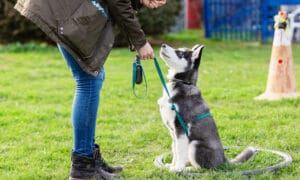“This post contains affiliate links, and I will be compensated if you make a purchase after clicking on my links.”
If your dog is a show dog or working dog, or you plan for it to be one, then you should understand the basics of Athletic Conditioning and Training For Working And Show Dogs. If your dog needs to be physically fit and always on the go for various events, dog shows, canine jobs, and anything which requires physical ability, then you might want to consider the right conditioning strategy for him, just as a normal human athlete would do.
Conditioning is a process of helping your dog become physically and mentally prepared for the challenges that await him, just as a student studies late at night to prepare for an exam or a test. Conditioning also reduces stress and anxiety before and during the event. In this article, we will give you a short guide in conditioning and training your sporty canine friend.
Athletic Conditioning And Training For Working And Show Dogs
First off, you have to know how fit or compatible your dog is for a particular sport event or a job. You have to first consider the breed. as well as the individual dog’s history and overall health and age. Different breeds are built for different types of sports. For example, sled dogs have different physical abilities than guard dogs and hunting dogs. The dog should be a breed whose eyes and joints are not normally prone to problems, and also your particular dog should not have any history of eye or joint problems. Not only that, other physical aspects such as the dog’s build can also be crucial to his career.
Second, ideally your dog should have started training as a puppy if you really intend him to be a canine athlete, just as human athletes in gymnastics and other sports start training while they are young. A puppy must be well-socialized and know how to obey simple rules such as “sit”, “heel”, “come”, and “stand” or “down”. Some vets advise puppy kindergarten or obedience classes for starters.
Third, socialization is very important, because your dog will be working in all sorts of different environments. To prevent your dog from getting easily scared, he has to be properly introduced to his working world, and must be able to deal with all kinds of weather conditions, atmospheres, and objects. For example: hunting dogs must be accustomed to the woods and forests; therapy dogs must be accustomed to hospitals, clinics, and medical equipment. It depends on where you want your puppy to be and what you want him to do.
Physical conditioning comes next, and can be done with simple exercises, even walking for a few hours a day. Your dog may also undergo some agility exercises to sharpen his skills, both physically and mentally. Stretching is also effective and some dogs can be trained to stretch. Swimming can also strengthen a dog’s muscles and endurance.
Keep in mind that your training schedule should be neither too harsh nor too soft, but just right for your dog, because different breeds have different capacities. Also, when it comes to adult dogs, you can still teach them lots of things, or give them obedience training, coupled with patience, perseverance, hard work, and of course, care for them.
But if you really want your dog to become a professional, then you probably also need the help of a professional trainer who will guide your dog into his chosen career path, and who specifically knows what the dog needs to be able to do. In fact, several organizations and groups offer training and tests for young canine aspirants.
A good example is the training of police dogs to sniff out drugs. The method used is something I would never have thought of, and is explained in this excerpt from an article on the HowStuffWorks.com website:
People often wonder if dogs sniff out hidden drugs because they want to eat them, or because they’re addicted to drugs themselves. In fact, the dogs have absolutely no interest in drugs. What they’re actually looking for is their favorite toy. Their training has led them to associate that toy with the smell of drugs.
The specific method used is thoroughly explained in the article, and is quite informative. That’s what you would call knowing the “tricks of the trade”. The professional trainers know these shortcuts and really seem to have a thorough understanding of the dog and how it thinks and works. So if your dog needs some Athletic Conditioning And Training For Working And Show Dogs, you should seriously consider consulting a professional trainer, at least initially.
Have you trained or had your dog trained for some specialized work or shows? Please share your comments below.



















Rita
May 30, 2013 at 12:46 pm
An outstanding share! I’ve just forwarded this onto a friend who had been conducting a little research on this. And he actually bought me lunch due to the fact that I found it for him… lol. So allow me to reword this…. Thank YOU for the meal!! But yeah, thanx for spending the time to discuss this subject here on your web site.